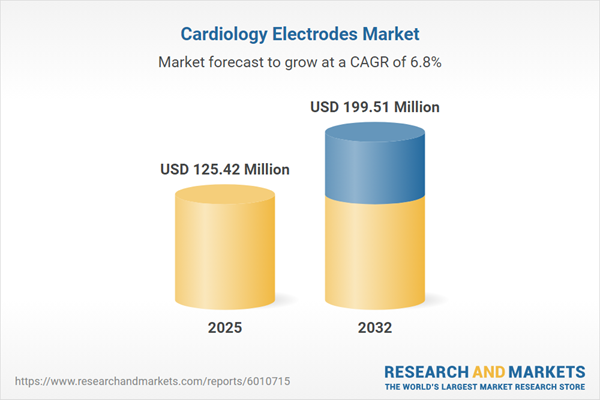Speak directly to the analyst to clarify any post sales queries you may have.
The cardiology electrodes market is undergoing rapid transformation, driven by technological developments and evolving healthcare models that are shifting the delivery of cardiovascular monitoring globally.
Market Snapshot: Cardiology Electrodes Market Overview
The Cardiology Electrodes Market grew from USD 117.51 million in 2024 to USD 125.42 million in 2025. It is expected to continue growing at a CAGR of 6.84%, reaching USD 199.51 million by 2032. Increasing emphasis on non-invasive cardiac diagnostics and monitoring, a growing prevalence of cardiovascular disease, and expanded adoption of remote patient care are reshaping demand and competition across regions. Tariff changes in the United States and continued product advancements are influencing industry strategies as stakeholders adapt to a changing regulatory and operational landscape.
Scope & Segmentation of the Cardiology Electrodes Market
This in-depth study analyzes the global landscape and covers critical sub-segments shaping market structure and competitive dynamics:
- Product Types: ECG electrodes (dry, hydrogel, pre-gelled), Holter monitoring electrodes (multi-lead, single-lead), ICU monitoring electrodes (fetal, intraoperative, telemetry)
- Materials: Carbon, polymer, and silver silver chloride (non-gelled, pre-gelled) formulations
- End Users: Ambulatory care centers, home care (professional use, self-diagnostic), and hospitals (private, public)
- Applications: Diagnostic monitoring (resting, stress testing), and therapeutic monitoring (pacing, electrophysiology)
- Technologies: Wired electrodes, wireless electrodes (Bluetooth, Wi-Fi enabled)
- Regions: Americas (United States, Canada, Mexico, Brazil, Argentina, Chile, Colombia, Peru), Europe, Middle East & Africa (United Kingdom, Germany, France, Russia, Italy, Spain, Netherlands, Sweden, Poland, Switzerland, United Arab Emirates, Saudi Arabia, Qatar, Turkey, Israel, South Africa, Nigeria, Egypt, Kenya), Asia-Pacific (China, India, Japan, Australia, South Korea, Indonesia, Thailand, Malaysia, Singapore, Taiwan)
- Leading Companies: 3M Company, GE HealthCare Technologies Inc, Koninklijke Philips N.V., Medtronic plc, Cardinal Health, Inc., Ambu A/S, Nihon Kohden Corporation, Smiths Group plc, Natus Medical Incorporated, Spacelabs Healthcare, Inc
Key Takeaways for Decision Makers
- Material innovation is elevating performance and comfort, with conductive polymers and new gel technologies reducing skin irritation and supporting longer monitoring durations.
- Migration to wireless electrode platforms is accelerating, facilitating real-time data capture and integrating seamlessly with telehealth solutions for remote cardiac diagnostics.
- Demand patterns are shifting as home care and ambulatory settings drive adoption of user-friendly electrodes and AI-powered analytics enhance clinician decision-making capabilities.
- Strategic manufacturer partnerships, R&D investment, and vertical integration are bolstering differentiation and supporting agile responses to supply chain challenges and tariff changes.
- Regional variations in regulation and reimbursement require tailored go-to-market approaches, with particular growth opportunities in Asia-Pacific and emerging healthcare systems.
Tariff Impact on Supply Chain and Market Competitiveness
Tariffs on cardiac monitoring components, enacted in the United States in 2025, have increased input costs—particularly for materials like silver silver chloride and specialty polymers. These policy shifts are prompting manufacturers to reevaluate sourcing strategies, implement process automation, and consider regionalizing production capacities. As a result, the competitive environment is witnessing regional diversification and new alliances, with downstream effects on pricing and accessibility for outpatient and home care providers.
Methodology & Data Sources
This report utilizes a mixed-methodology framework, combining direct interviews with market stakeholders—cardiologists, biomedical engineers, procurement managers, and key opinion leaders—with a comprehensive review of peer-reviewed publications, regulatory filings, patent databases, and industry association intelligence. Data triangulation and scenario analysis underpin the findings, supported by ongoing expert peer review to ensure accuracy and ethical standards.
Why This Report Matters
- Provides actionable insights for evaluating investment in next-generation electrode platforms and digital health partnerships.
- Helps align product development and market entry strategies with near-term regulatory changes and regional variations in care delivery.
- Enables senior decision-makers to anticipate disruption, optimize operational efficiency, and strengthen supply chain resilience amid evolving market forces.
Conclusion
Driven by innovation and structural shifts in healthcare delivery, the cardiology electrodes market is evolving into a more agile, technology-integrated sector. This research delivers the strategic foundation needed to navigate market complexities and secure sustainable growth opportunities.
Additional Product Information:
- Purchase of this report includes 1 year online access with quarterly updates.
- This report can be updated on request. Please contact our Customer Experience team using the Ask a Question widget on our website.
Table of Contents
3. Executive Summary
4. Market Overview
7. Cumulative Impact of Artificial Intelligence 2025
Companies Mentioned
The companies profiled in this Cardiology Electrodes market report include:- 3M Company
- GE HealthCare Technologies Inc
- Koninklijke Philips N.V.
- Medtronic plc
- Cardinal Health, Inc.
- Ambu A/S
- Nihon Kohden Corporation
- Smiths Group plc
- Natus Medical Incorporated
- Spacelabs Healthcare, Inc
Table Information
| Report Attribute | Details |
|---|---|
| No. of Pages | 184 |
| Published | November 2025 |
| Forecast Period | 2025 - 2032 |
| Estimated Market Value ( USD | $ 125.42 Million |
| Forecasted Market Value ( USD | $ 199.51 Million |
| Compound Annual Growth Rate | 6.8% |
| Regions Covered | Global |
| No. of Companies Mentioned | 11 |









